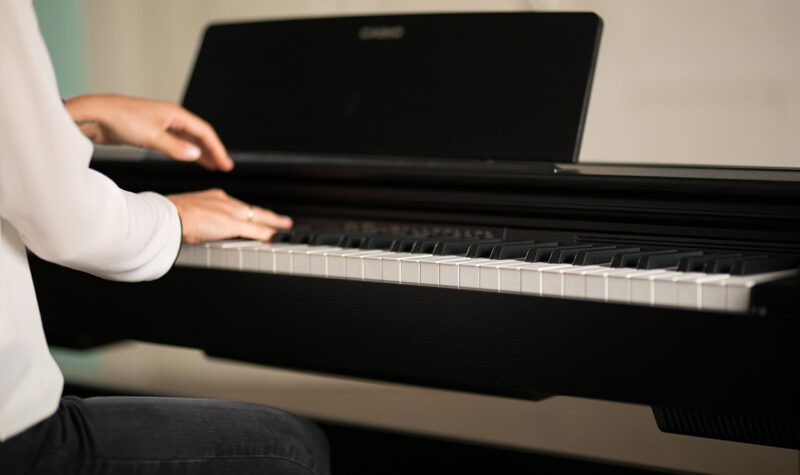In today’s article, we’re going to tackle one of the most commonly asked questions by piano shoppers; What are the differences between electric pianos vs digital pianos? Are they just the same thing? And which one should you be shopping for?
Read on and find out!
Electric vs Digital Pianos: Are They the Same Thing?
Let’s start by dealing with these somewhat clumsy labels and provide some clarity. While both digital and electronic pianos use electricity, they’re most definitely not the same thing.
If you’re looking for a piano that runs on electricity these days, whether on Amazon or in a showroom, you’re most certainly looking for a digital piano, not an electric piano, unless you’re specifically looking for a vintage instrument.
What is an Electric Piano?
Electric pianos, at least as we define them within the music business, refer to a piano which uses an analog electric component to pick up and/or amplify the sound generated by a string or some other kind of resonating metallic object.
An electric guitar is actually a perfect comparison, as we have a resonating string that interacts with a magnetic field which generates a wave shape in the electric current that can be subsequently amplified.
Anyone familiar with 1970s music in the Motown, R&B, or pop vein will undoubtedly be familiar with the classic sounds of various electric pianos such as Rhodes, Wurlitzer, and Yamaha.
Why Electric and not Digital?
What exactly makes a piano electric and not digital? Well, quite literally, the lack of digits. Even though electrons were flowing around, none of it was being turned into ones and zeroes. There wasn’t a microprocessor to be found, which is one of the most basic requirements to call something a digital device.
Under this set of definitions, there aren’t any electric pianos being manufactured or sold today with the way technology has evolved over the past several decades, with maybe a couple of exceptions in the synth realm.
That said, certain vintage electric pianos are coveted on the second-hand market for their unique timbre, even though manufacturers like Roland, Casio, Kawai, Nord stage pianos, and various VST companies all produce very convincing electric piano patches.
What is a Digital Piano?

Digital pianos generate tone in one of three ways. The first is by replaying samples of a real instrument that’s been digitally stored, and this covers the vast majority of mid to high-end digital pianos currently being produced.
The second method involves generating different pitches based on a single PCM shape, and this is similar to how general MIDI sounds work. This method is, of course, common with synthesizers.
The last method involves tone being generated in real-time through complex algorithms, and this method is called modelling, which is still relatively rare among digital keyboards.
Which one Should you Consider?
Now that we’ve clarified the differences between Electric and Digital pianos, which one should you be looking for? Unless you’re a professional keyboard player or vintage instrument enthusiast, you are most certainly looking for a digital piano.
Digital pianos have dramatically improved in quality and come down in price over the last 10 years for much wider accessibility. And just within the last two or three years, many instruments, even in the entry-level $500 USD range from companies like Alesis and Korg, will provide a sufficient musical experience to take your first piano lessons on.

Snapshot of the Digital Piano Market Today
The average price of a digital sold in 2020 is around $850 US or $1,100 Canadian with popular models like Yamaha digital pianos such as the Yamaha P125, Yamaha P45, and the YDP Arius and Clavinova series. Other best-selling models such as the Casio Privia PX and CDP series instruments also provide a stellar portable keyboard experience, and there are even arranger portable digital pianos available at this price point too.
Musical instruments in this price range are increasing offerings of modern technology such as Bluetooth Connectivity, quality hammer actions, believable sustain pedals, metronomes and various output jacks.
The best digital pianos in terms of quality range from $5,000-$15,000 USD, with some even featuring things like genuine acoustic grand and upright piano key actions with wooden keys and high-end speaker systems and amplifiers for exceptional piano sound.
Final Thoughts
We hope this article has helped clarify the differences between electric and digital pianos. As we’ve said, unless you’re specifically looking on the private market or with a vintage gear retailer, you’re almost 100% going to be looking at a digital piano.
Thanks for reading!
